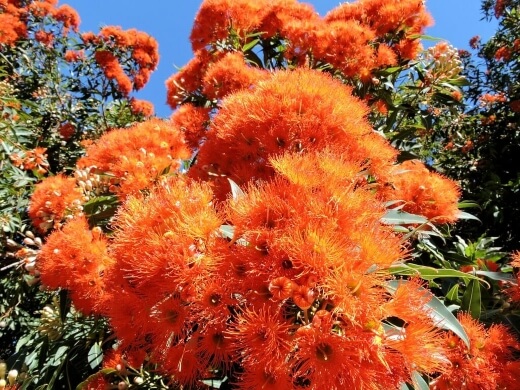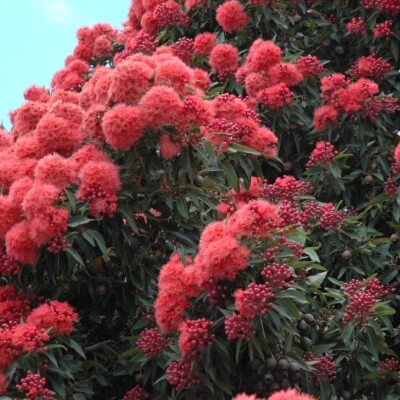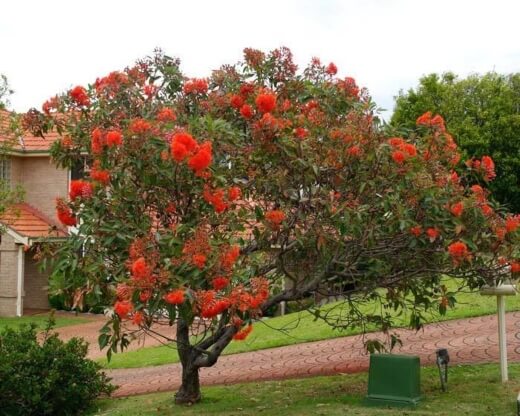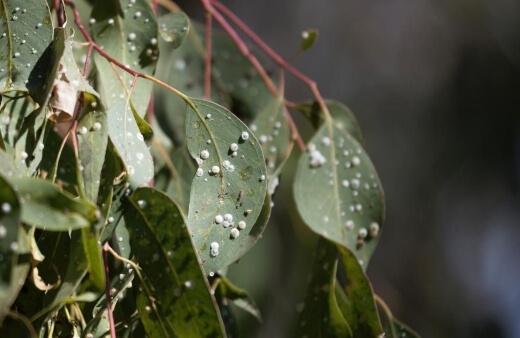Corymbia ficifolia is truly a beautiful specimen. The brilliant bright red colour of the flowers that looks almost like a flame on the tree is the right splash of colour to compliment any garden setting.
In our how to grow and care guide, we’ll look at an introduction to the Corymbia ficifolia, how to grow and care for your tree, propagation techniques from seed and cuttings, pests and diseases, and some frequently asked questions about this eye-catching tree.
More...
Family: | Myrtaceae |
|---|---|
Genus: | Corymbia |
Species: | C. ficifolia |
Common Names: | Red flowering gum |
Location: | Outdoor |
Type: | Tree |
Growth: | Up to 12 metres in height and up to 5 metres in width |
Sun requirements: | Full sun |
Foliage Colour: | Dark green |
Flower Colour: | Red |
Flowering: | Mid-summer |
Fruit: | Yes |
Maintenance level: | Low |
Poisonous for pets: | No |
Introducing Corymbia ficifolia

Corymbia ficifolia is more often known as the red flowering gum. This small tree is endemic to Western Australia. The tree was first named by Ferdinand von Mueller in 1860 but he gave it the name Eucalyptus ficifolia.
Only more recently in 1995 did the name of the tree become Corymbia ficifolia. The red flowering gum is cultivated in abundance both locally and internationally.
It loves areas that have a limited rainfall in summer. You wouldn’t find it thriving on the Australian east coast for example.
Red Flowering Gum Growing Habits
In the right climate, Corymbia ficifolia can grow quite quickly, about 60cm per year. They can be difficult to propagate from cuttings and this is usually done with seed.
The flowers of the Corymbia ficifolia really put on a show, with a generous display of flowers arriving in summer and then popping up during the rest of the year. The flowers can actually be a variety of colours – red, pink, orange, white and even mixed colours.
Sometimes, the flowers are so plentiful you can barely see the leaves. The delightful blooms of course attract a host of wildlife who come to enjoy the nectar.
After the flowers comes a woody sort of barrel shaped fruit. These stay on the tree for almost a year before falling off.

Uses for Corymbia ficifolia
The Corymbia ficifolia can handle drought and high temperatures really well, even pollution and salt spray. It’s often used to line streets or to help provide shade.
Sometimes a few of them are planted together to create a hedge or fence and this tree is also a fantastic windbreak. The tree usually blooms around its seventh year and Corymbia ficifolia takes about 15 years before it reaches full height.
The flowers don’t actually have petals – it’s the colourful stamens that make the flowers look so fluffy. The leaves are also eye-catching with a bronze colour that becomes dark green on top with a lighter shade on the bottom of the leaf.
The reason Corymbia ficifolia does so well in Western Australia is because summer is dry and hot and winter is warm and wet. In terms of soil, this tree can handle even the roughest and toughest soil that is sandy and infertile.
Just don’t give it heavy clay and make sure the roots are not damp otherwise you’ll have root rot on your hands.


Get Your Free Guide:
Master Growing Australian Natives eBook
A Must Have Complete Guide for Every Australian Garden
Get Your Free Guide:
Master Growing Australian Natives eBook
A Must Have Complete Guide for Every Australian Garden
Popular Corymbia Varieties
In terms of cultivars, there are a few that have actually been created to handle the humidity of Eastern Australia. Some of the popular varieties include:
Corymbia ficifolia ‘Wildfire’This cultivar has a red brown new leaf growth that eventually becomes green and lush with red flowers in summer. If you have a garden with limited space, this variety is perfect as it grows to a maximum of 6 metres in height. |  |
Corymbia ficifolia ‘Wild Sunset’This variety is also small and compact. The new leaves are bronze in colour and then turn a dark green and have a leather feel. This tree grows up to 6 metres in height. |  Source: thetutuguru.com.au |
Corymbia ‘Summer Red’This variety is small to medium in size and has lovely pink red flowers in the summertime. The tree has a round shape and grows up to 5 metres tall. |  Source: alpinenurseries.com.au |
Corymbia ficifolia ‘Calypso’This rounded tree has salmon pink flowers and grows to a height of 5 metres. |  Source: flowerpower.com.au |
Corymbia ficifolia ‘Wildfire’

This cultivar has a red brown new leaf growth that eventually becomes green and lush with red flowers in summer. If you have a garden with limited space, this variety is perfect as it grows to a maximum of 6 metres in height.
Corymbia ficifolia ‘Wild Sunset’

Source: thetutuguru.com.au
This variety is also small and compact. The new leaves are bronze in colour and then turn a dark green and have a leather feel. This tree grows up to 6 metres in height.
Corymbia ‘Summer Red’

Source: alpinenurseries.com.au
This variety is small to medium in size and has lovely pink red flowers in the summertime. The tree has a round shape and grows up to 5 metres tall.
Corymbia ficifolia ‘Calypso’

Source: flowerpower.com.au
This rounded tree has salmon pink flowers and grows to a height of 5 metres.
How to Grow Corymbia ficifolia

Source: growyoursecretgarden.com
Sunlight Preference
Full sun is the way to go with this tree. Your Corymbia ficifolia is the equivalent of someone who likes to tan without sunscreen in the heat of the day.
Full sun usually means 6 hours or more of direct sunlight and partial sun would be between 3 and 6 hours of direct light.
Best Soil for Corymbia ficifolia
Corymbia ficifolia likes moist soil that is well-draining like sandy loam. It will however do alright in a lighter soil if necessary.
Fertilising
A young Corymbia ficifolia needs an extra boost of phosphorus to help its root development so you can apply a relevant fertiliser when planting and then during the first growing season.
Once your tree is established it will still benefit from fertilising and you can use a water-soluble one each month.
Caring for Red Flowering Gum Tree

Source: alchetron.com
Watering Needs
When watering your Corymbia ficifolia, the ideal is a deep watering but then not too often. You’re doing this so there is enough water to wet the root ball of the tree.
The best time to water is early in the morning or late afternoon. If you’re having issues with fungus attacking your plant, an earlier watering in the day is best so the leaves can dry out before night time.
Pruning Red Flowering Gum
There are a couple of different ways of pruning that you can do with your Corymbia ficifolia. Pinching is the first one – this is when you snip off the tip of the stems and this helps the tree to grow branches. It also means you won’t need to be too ruthless when you prune an older tree.
In some cases, gardeners need to cut off entire branches to allow more light and air access to the tree. This of course helps to prevent diseases.
The thinning process is useful too if you’re getting rid of dead trees. You can also get rid of old branches if you want to shape and resize your tree.
Corymbia ficifolia Propagation

Growing Red Flowering Gum from Seeds
Corymbia ficifolia is quite simple to grow from seed. You can prepare a 10cm pot/s with sandy soil, water well and press it down. Put the seed on its side and you can cover slightly with the soil.
The pot then needs to be somewhere warm and in shade. You also need to keep your mixture moist for germination to happen – this is anywhere between 7 to 21 days.
Our advice is to sow your seeds in the springtime, even late spring depending on the climate.
Red Flowering Gum Propagation from Cuttings
Propagating Corymbia ficifolia is easier from seed but if you want to go the cuttings root, here is the process to follow. Take 10cm in length shoots that are mature and then dip in rooting hormone for half a minute.
Make sure your cutting has at least one new leaf growing. Any extra leaves can be taken off. You’ll need a container filled with perlite and pop the cutting into the mix.
Fill a saucer with water and let the plant absorb enough from the bottom until the soil is moist. You can then cover the cutting with a plastic bag and place it somewhere warm.
Ideally you want to maintain a temperature around 32°C and keep the cutting mixture moist. It takes about 4 weeks for roots to grow and then you’re ready for planting somewhere more permanent.
Pests and Diseases that Affect Corymbia ficifolia
Canker
This disease is caused by a fungus that starts with the bark and infiltrates the inside of the tree. You’ll know something is off when the leaves become yellow and start dropping off.
The tree might even lose some branches in the process. The canker actually causes the tree trunk to start splitting open. One of the best ways to manage this kind of disease is to keep your tree stress free.
Make sure it’s getting enough water as well as mulch, and prune sufficiently to try and avoid canker. If this disease has taken hold of your Corymbia ficifolia, cut off as much as you can to try and limit the infection so it doesn’t spread further.
As a guideline, prune if the weather is dry and sterilise your tools. You can cut about 10cm below the canker when removing the affected parts.
Phytophthora
This fungus is quite common – the name more often used is root rot. The leaves start to discolour and the wood under the bark becomes a red brown colour. It’s not all doom and gloom though.
Sometimes you can save the tree. You would need to remove the soil around the base down to the top of the main roots. The root system needs to be open and you can also cut off bark that looks like it's oozing.
The reason you want to leave the roots exposed is so they can dry out. This actually slows down the fungus spread.
Red gum lerp psyllid

These pests create a white cover for protection, called lerps. The honeydew they secrete can sometimes be seen dripping from the tree. If there are enough of these insects, the tree becomes distressed and the leaves might start falling off.
As if one pest wasn’t enough, the lerps can attract long-horned borers. The females will lay their eggs and the larvae then burrow into the tree. The damage affects the trees ability to draw up water from the roots and can kill off the tree quite quickly.
In terms of treatment for psyllids, you might be imagining that you need something quite extreme. The best defence is actually encouraging the right kind of insects to visit your garden to keep the pests under control.
If the damage is particularly bad, you can spray each week with neem oil or an insecticidal soap. You can’t get rid of psyllids with pruning as they just jump off.
Heart or trunk rot
This fungus attacks your Corymbia ficifolia on the inside and then works its way out. It causes the branches to droop but by this time your tree is on its way out and there’s not much more you can do.
You can do your best to try and prevent the spread of the fungus as with the other diseases. Again, remember to clean your tools afterwards.
Corymbia ficifolia Frequently Asked Questions

Source: monaconatureencyclopedia.com
Where does the Corymbia ficifolia get its name?
Corymbia comes from the Latin word corymbium which refers to a corymb which describes flowers that are arranged in clusters. Ficifolia is Latin for ficus, referring to the genus Ficus.
Folium means leaf, and the leaves are actually similar to some Ficus species. The Corymbia genus includes about a hundred species of tree which are also known as bloodwoods, as they bleed red sap.
Where would you find the world’s biggest Corymbia ficifolia?
The largest tree of this species known in the world is 216.5 cm in diameter and is found in Hamilton, New Zealand.
Is Corymbia the same as Eucalyptus?
The genus Angophora, Corymbia and Eucalyptus, are indeed related and as a group are called eucalypts.
If you enjoyed reading this article, why not sign up for our newsletter for more gardening inspiration, information and tips.
Add Astounding Colour to Your Garden with the Corymbia ficifolia
Corymbia ficifolia could easily be described as one of Western Australia’s gems. The colour of the flowers alone are astounding, and the birdlife they attract just makes the garden even more beautiful.
With many cultivars to choose from and easy propagation from seed, there’s no reason why you can’t have your very own red flowering gum. We’re giving Corymbia ficifolia our green thumbs up.
Published on August 17, 2022 by Gary Clarke
Last Updated on January 21, 2025




